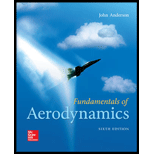
Consider an oblique shock wave with a wave angle of
The pressure.
The temperature.
The Mach number.
The total pressure.
The total temperature behind the wave.
The entropy increase.
Answer to Problem 9.2P
The pressure is
The temperature is
The Mach number is
The total pressure is
The total temperature behind the wave is
The entropy increase is
Explanation of Solution
Given:
The upstream temperature is
The upstream pressure is
The wave angle of the shock wave is
The Mach number is
Formula Used:
The expression for the normal component of upstream Mach number is given as,
Here,
The expression for total upstream pressure is given as,
Here,
The expression for the upstream temperature is given as,
The expression for the downstream static pressure is given as,
The expression for the downstream static temperature is given as,
The expression for the downstream normal Mach number is given as,
The expression for the entropy increase across oplique shock wave is given as,
Here,
Calculation:
Thenormal component of upstream Mach number can be calculated as,
The total upstream pressure can be calculated as,
The upstream temperature can be calculated as,
The downstream static pressure can be calculated as,
The downstream static temperature can be calculated as,
The downstream normal Mach number can be calculated as,
The deflection angle can be calculated as,
The angle between downstream flow and oblique shock wave can be calculated as,
The total downstream pressure can be calculated as,
The temperature does not change across shock wave and will be,
The expression for the entropy increase across oplique shock wave is given as,
Conclusion:
Therefore, the pressure is
Therefore, the temperature is
Therefore, the Mach number is
Therefore, the total pressure is
Therefore, the total temperature behind the wave is
Therefore, the entropy increase is
Want to see more full solutions like this?
Chapter 9 Solutions
Fundamentals of Aerodynamics
Additional Engineering Textbook Solutions
Thermodynamics: An Engineering Approach
Elementary Surveying: An Introduction To Geomatics (15th Edition)
Mechanics of Materials (10th Edition)
Starting Out with C++ from Control Structures to Objects (9th Edition)
Fluid Mechanics: Fundamentals and Applications
Starting Out with Programming Logic and Design (5th Edition) (What's New in Computer Science)
- CE-112 please solve this problem step by step and give me the correct answerarrow_forwardCE-112 solve this problem step by step and give me the correct answer pleasearrow_forwardPlease do not use any AI tools to solve this question. I need a fully manual, step-by-step solution with clear explanations, as if it were done by a human tutor. No AI-generated responses, please.arrow_forward
- Please do not use any AI tools to solve this question. I need a fully manual, step-by-step solution with clear explanations, as if it were done by a human tutor. No AI-generated responses, please.arrow_forwardCE-112 please solve this problem step by step and give me the correct answerarrow_forwardCE-112 please solve this problem step by step and give me the correct asnwerarrow_forward
- this is an old practice exam, the answer is Ax = -4, Ay = -12,Az = 32.5, Bx= 34, Bz = 5, By = 0 but how?arrow_forwardThis is an old practice exam, the answer is Ax = Az = 0, Ay = 2000, TDE = 4750, Cx = 2000, Cy = 2000, Cz = -800 but how?arrow_forwardthis is an old practice exam, the answer is Fmin = 290.5lb but howarrow_forward
- This is an exam review question. The answer is Pmin = 622.9 lb but whyarrow_forwardPlease do not use any AI tools to solve this question. I need a fully manual, step-by-step solution with clear explanations, as if it were done by a human tutor. No AI-generated responses, please.arrow_forwardPlease do not use any AI tools to solve this question. I need a fully manual, step-by-step solution with clear explanations, as if it were done by a human tutor. No AI-generated responses, please.arrow_forward
 Principles of Heat Transfer (Activate Learning wi...Mechanical EngineeringISBN:9781305387102Author:Kreith, Frank; Manglik, Raj M.Publisher:Cengage Learning
Principles of Heat Transfer (Activate Learning wi...Mechanical EngineeringISBN:9781305387102Author:Kreith, Frank; Manglik, Raj M.Publisher:Cengage Learning Refrigeration and Air Conditioning Technology (Mi...Mechanical EngineeringISBN:9781305578296Author:John Tomczyk, Eugene Silberstein, Bill Whitman, Bill JohnsonPublisher:Cengage Learning
Refrigeration and Air Conditioning Technology (Mi...Mechanical EngineeringISBN:9781305578296Author:John Tomczyk, Eugene Silberstein, Bill Whitman, Bill JohnsonPublisher:Cengage Learning Automotive Technology: A Systems Approach (MindTa...Mechanical EngineeringISBN:9781133612315Author:Jack Erjavec, Rob ThompsonPublisher:Cengage Learning
Automotive Technology: A Systems Approach (MindTa...Mechanical EngineeringISBN:9781133612315Author:Jack Erjavec, Rob ThompsonPublisher:Cengage Learning


